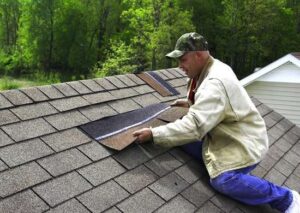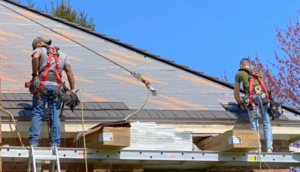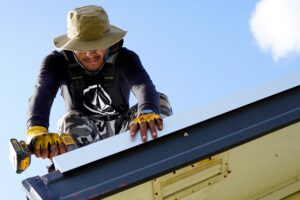Gutters filled with rotten leaves, twigs, and bird droppings can become a breeding ground for mosquitoes and rodents. Regular gutter cleaning can also prevent basement flooding that can damage furniture and other items housed in the cellar.
While the normal guidance is to clean your gutters bi-annually, specific home conditions may call for more frequent attention. For more information about gutter cleaning visit Roof Cleaning Summerville SC.

A gutter is integral for funneling rainwater and debris to a designated spot far from a home’s foundation. Still, gutters can become clogged with dirt, leaves, twigs, and other materials. When left unchecked, a clogged gutter can cause water to spill over the sides of the troughs and into the siding, roofing, and foundation of a house, damaging the structure.
A clogged gutter can also invite rodents and insects to nest near the home, leading to an infestation. Proper gutter cleaning can prevent these issues, but it is important to take the necessary safety precautions before climbing a ladder.
Ladder safety is essential, as thousands of people are treated for ladder-related injuries each year, and hundreds die from falling off of them. A proper ladder must be set up on stable ground, and it is a good idea to have someone nearby to hold the ladder, control foot traffic, and call for help in an emergency.
It is also a good idea to wear gloves and eye protection when working with dirty, rotting gutter debris that often contains bird, frog, and squirrel poop, along with bacteria and other pathogens. The right type of glove can make it easy to grip cleaning tools and minimize hand contact with the contaminants. Gloves should be thick enough to protect hands from ragged metal shards and other sharp items in the gutter, as well as from mold and mildew that can grow on wet, organic material. Leather or suede gloves are a better choice than cotton, plastic, or rubber gloves.
While it may be tempting to hurry the process by overreaching for a hard-to-reach section of the gutter, doing so can easily result in a fall off the ladder or the roof. Instead, it is best to work steadily and deliberately until all sections are clean.
It is also a good idea to rake or power wash the roof before cleaning the gutters. Otherwise, the next rain will pass all the loose dirt and tree leaves into the clean gutters, causing them to clog up again.
A clean gutter system helps prevent rainwater from flowing over a roof’s edge and into the home or onto and under siding. It also directs water into downspouts that drain away from a house’s foundation and exterior. A clogged gutter can lead to some problems, including water damage and leaks.
If your gutters are clogged, hiring a professional to clean them may be your best bet. They have the proper equipment to access high gutters from the ground without risking your safety. They will clear debris and wipe down gutters, too, ensuring that moss, rust, dirt, leaves, and other contaminants are fully erased.
Gutter cleaning is a job that requires a ladder, and a sturdy one at that. Experts recommend using an extension ladder that extends at least 4 feet above the gutter height and avoiding stepladders prone to tipping over if you lose your balance. Always use the three-points-of-contact rule while working on a ladder: Both feet should be securely on the ladder, and one hand should hold on to it.
Ladder accessories like the Gutter Getter Scoop can help you clean your gutters safely. These large plastic scoops lift and scoop debris from the top of a gutter, dropping it into a trash can or tarp spread below. These tools can be awkward to work with, however, as you have to remain on a ladder and move it every few feet as you work.
Alternatively, you can use a water-fed gutter brush tool that attaches to a garden hose and uses a nozzle to brush and wash the gutters. Some models have angled heads that can fit inside your gutter, making them easier to work with. This type of tool can be physically demanding as well because it requires you to hold the wand with both hands and control the flow of water or pressure from the hose.
Another option is a gutter vacuum, which can eliminate the need for a ladder in many cases by sucking up the debris as it falls. These tools can be messy, but they are effective and easy to use.
Gutter cleaning is a chore that many homeowners must do on a ladder, which can be dangerous. A fall off a ladder can be very serious and even life-threatening, which makes ladder safety an especially important part of any gutter-cleaning job. Ladders should always be inspected for damage or wear before using them, and they should be placed on stable ground with secure footing. In addition, all workers should use proper climbing techniques when working on a ladder and take frequent breaks.
In addition to a good ladder, all gutter cleaners should wear sturdy work gloves and protective eyewear. Gutter cleaning is a messy business, and you want to avoid reaching into clumps of dirty, rotting leaves barehanded. Also, you’ll likely need to hold tools like a gutter scoop, bucket for the muck, or a hammer for unanticipated repairs, and dropping a tool from a high place can cause damage or injury to someone below you on the ladder or your house.
For gutter cleaning and other home improvement projects, this lightweight telescoping ladder is the perfect choice. It extends to 15.5 feet, which is plenty of height for cleaning gutter systems in most homes. This ladder is made of aircraft-grade aluminum and features rugged square rungs that are safe to grip. It can handle a maximum load capacity of 330 pounds, and it has built-in feet that promote stability while scaling the ladder.
Another essential tool for gutter cleaning is a gutter brush, which can help loosen and remove organic debris from clogged gutters. Unlike a traditional broom, this handy tool has a rubber, non-skid surface that helps prevent slipping while climbing the ladder. It’s easy to rinse off when you’re finished, too.
As with any ladder-related project, you should always stay within reach when working on a ladder. It’s tempting to lean outside the side rails of a ladder when you’re on it, but overreaching is one of the leading causes of falls from ladders. Instead, keep both feet and hands on the ladder to maintain balance and avoid falling.
Gutter cleaning is a messy job that can lead to contamination, injury, and illness. It is important to have the right gear and clothing to protect yourself during this task. Gloves and safety goggles are essential to keep your hands and eyes safe from debris and potential contaminants. A dust mask will also help to protect your lungs from dust and particles that may be stirred up during the cleaning process. Rubber-soled shoes are also recommended for greater traction and stability when climbing ladders.
A sturdy ladder on solid and level ground is essential for gutter inspection and cleaning. Ensure the ladder is secure and does not move using ladder stabilizers, leg levelers, or standoffs. Ladders should not be leaned too far to the side, as this can cause it to tip and break. A good rule of thumb is to maintain three points of contact with the ladder at all times and never climb higher than you can.
Start the gutter cleaning process by hand removing large debris, such as twigs and leaves. These should be placed in a bucket or tarp below the ladder for easy disposal. Next, use a garden trowel or gutter scoop to remove the gunk and leaves from the gutters. Wear gloves to protect your hands from sharp and potentially hazardous debris. Once you’ve removed most of the debris, flush the gutters with a hose equipped with a spray nozzle to leave them squeaky clean.
Unless you have the proper equipment, it’s best to hire a professional gutter cleaner to avoid serious injury and damage to your home. Professional gutter cleaners are trained to use the proper equipment and cleaning methods to ensure the best results. They also have the insurance needed to cover any injuries or property damage that may occur while working on your roof or gutters. Professional gutter cleaners will also know how to spot and repair any problems with your roof or gutter system, ensuring your gutters are safe and functional for years.




